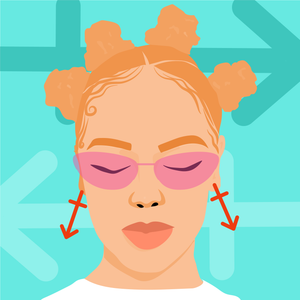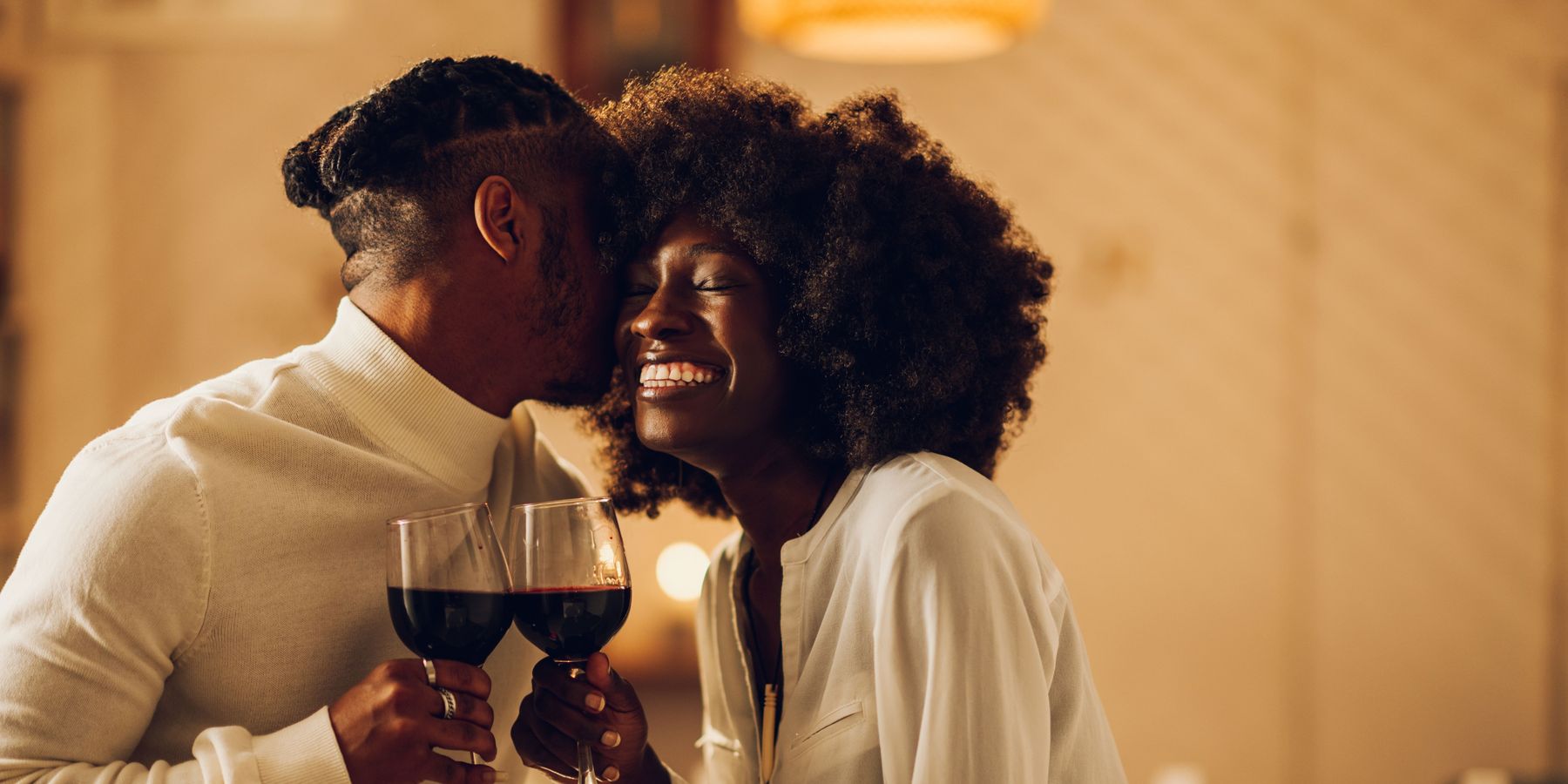
So, here’s the deal: if you’re over the age of 35, perimenopause can last anywhere from a few months to an entire freakin’ decade. And so, if you’re wondering why I’m talking about menopause more often these days…now you know.
Okay and just what does perimenopause and especially menopause have to do with your skin? Chile, where do I even start? SMDH. Probably the easiest way to explain it is that when your estrogen and progesterone levels drop (which is what automatically happens during that time of life), it can directly impact how your skin both looks and feels. Your skin may feel drier, thinner, or appear less “full” (meaning plump) — and all of that can make it look older than you want it to.
Honestly, that’s why a lot of skincare products are marketed as being “anti-aging”; it’s their gentle way of saying skin that is perimenopausal or menopausal. In fact, I actually read that during the first five years of menopause, it’s pretty common to lose as much as 30 percent of the collagen that’s in your system (check out “We Lose Collagen As We Age. 10 Ways To Naturally Boost It.”). And since collagen plays such a significant role in your skin retaining moisture, having elasticity, and avoiding the fine lines and wrinkles that most of us would prefer to put off for as long as we possibly can, it’s important to do what can be done, even now, to keep a youthful and radiant glow.
So, let’s get into it. Because there is indeed such a thing as menopause skincare (the anti-aging industry brings in literally billions of dollars every year because of it), I want to share 12 things that you can proactively do to care for your own skin: whether you’re in perimenopause, menopause, post-menopause or just…curious.
1. Eat More Phytoestrogens
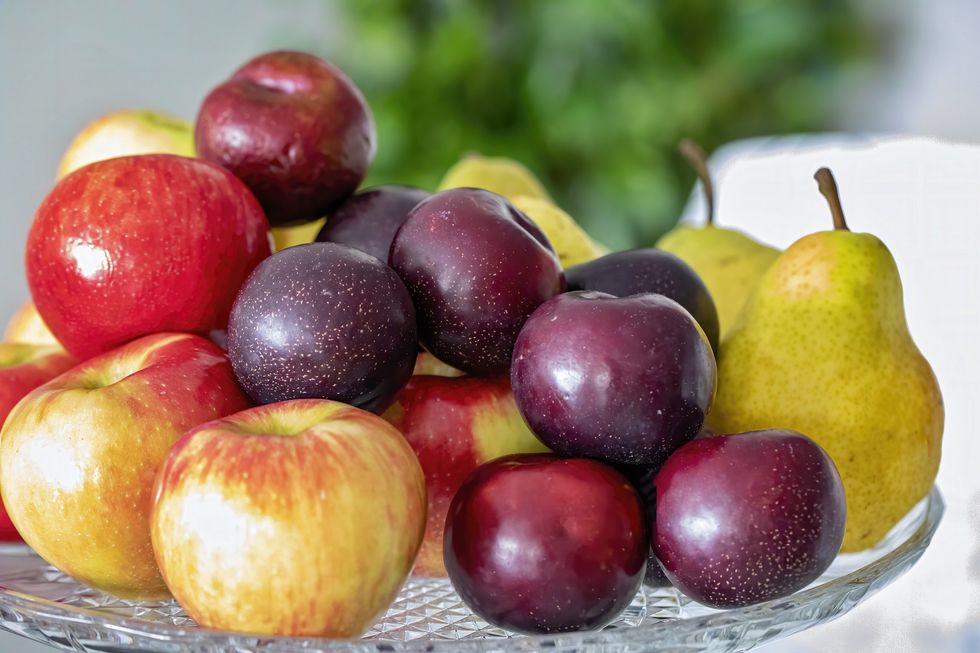
Getty Images
Okay, so since you lose quite a bit of estrogen during menopause, if you don’t want your skin to look like you did, you should consider consuming some phytoestrogens. Those are foods like dried fruits, garlic, plums, pears, apples, onions, and collards that come from plant-based estrogen. Since phytoestrogens are able to do everything from bring more hydration into your skin to boost your collagen levels, if you want to “push pause” on the aging process of your skin from the inside out, eating phytoestrogens is certainly one way to do it.
2. Also, Consume More Collagen-Enriched Foods
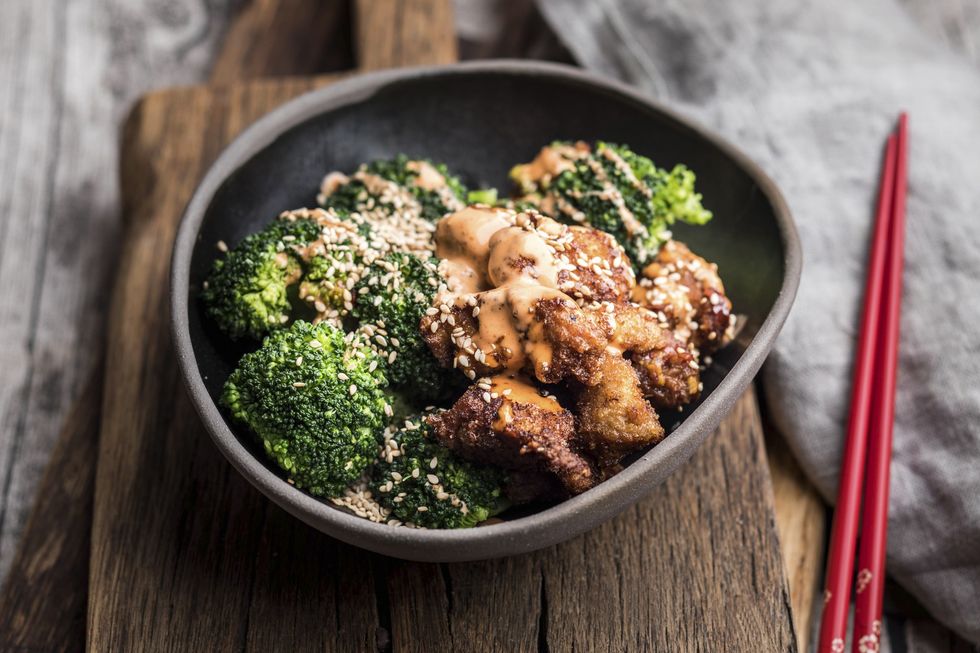
Getty Images
We already touched on what collagen is able to do, which is why it’s a good idea to eat foods that are rich in this particular structural protein as well. Chicken, broccoli, bone broth, berries, cashews, egg whites, and citrus fruit can get you right in this department. Know what else can? Green tea.
3. Enjoy Some Dark Chocolate
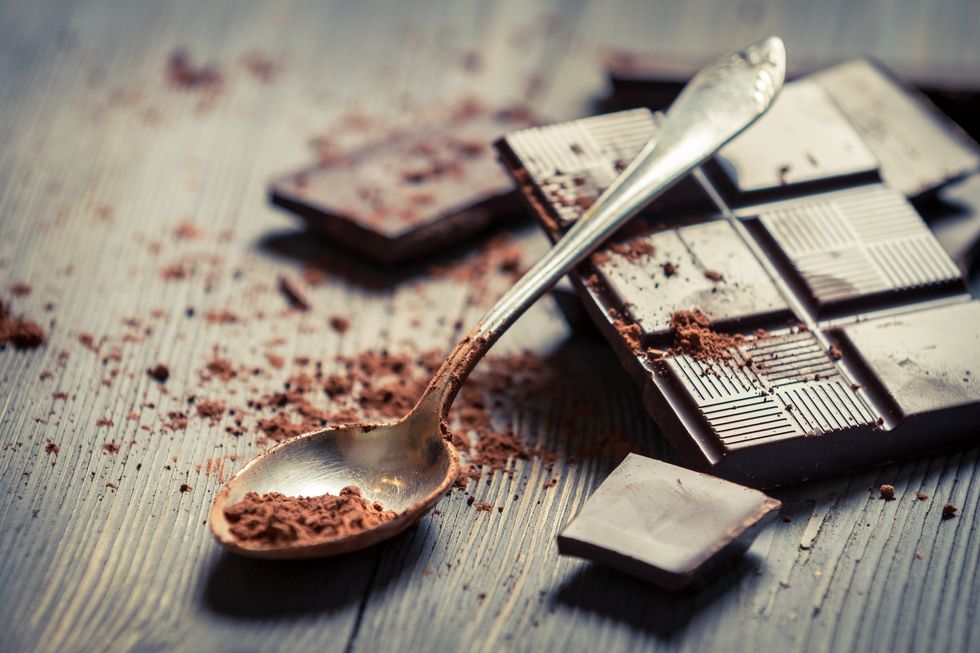
Getty Images
Women who are postmenopausal should consume dark chocolate on a consistent basis because it helps with their heart health. Something else that research reveals is dark chocolate is great when it comes to boosting cognitive function (which can also decline during menopause when it comes to your memory). Your skin could use dark chocolate because it increases blood circulation to it. Also, dark chocolate can protect your skin from damaging UV rays. And since dark chocolate helps to reduce stress, that is just one more reason to snack on it — and perhaps why you should consider applying a dark chocolate face mask a couple of times a month, too (you can check out some more info via StyleCraze on all of that here).
By the way, it should go on record that the key is not to pick up a Hershey’s bar on your way home. You need to eat the kind of dark chocolate that contains no less than 65-70 percent cocoa. Yep, the less sweet and more chalk-like it tastes, the better (just sayin’).
4. Put Aloe Vera Juice in Your Drinks
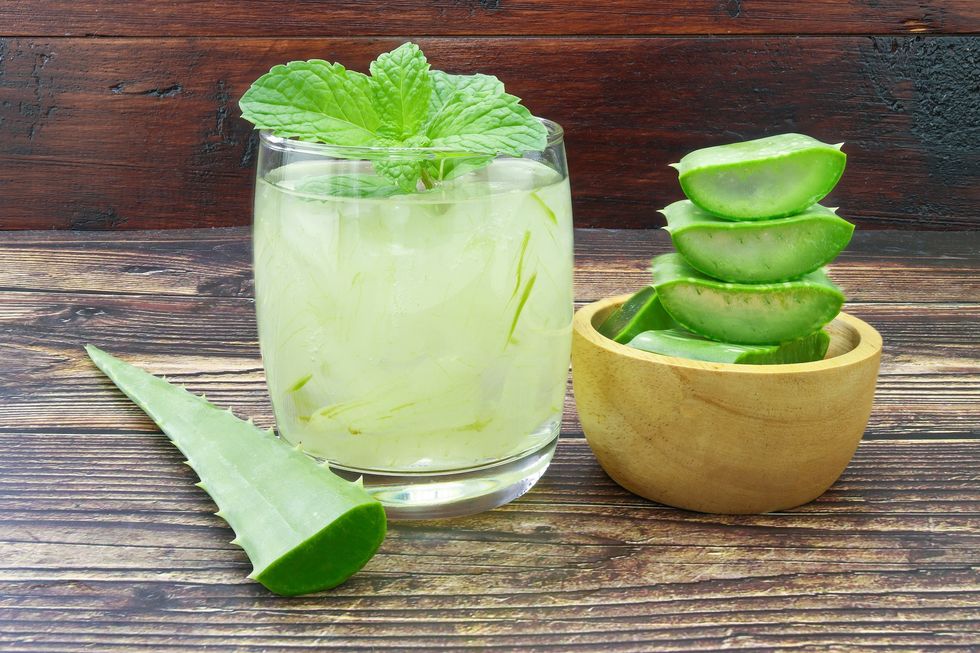
Getty Images
The antibacterial, antioxidant, and anti-inflammatory properties in (pure) aloe vera juice can do wonders for your system. Not only is it full of antioxidants and vitamin C, but aloe vera juice can also help to improve digestion, regulate your blood sugar levels, improve your oral health, soothe heartburn, and keep your vision healthy and strong. As far as your skin goes, aloe vera juice will definitely help it to maintain a proper level of moisture. As a bonus, it can also help to increase collagen production and improve elasticity in your skin.
Oh, if the thought of drinking aloe vera juice straight makes you slightly want to throw up in your mouth, take it from me that if you put a tablespoon in your juice or smoothie, you will hardly even notice that it’s there.
5. Up Your Water Intake
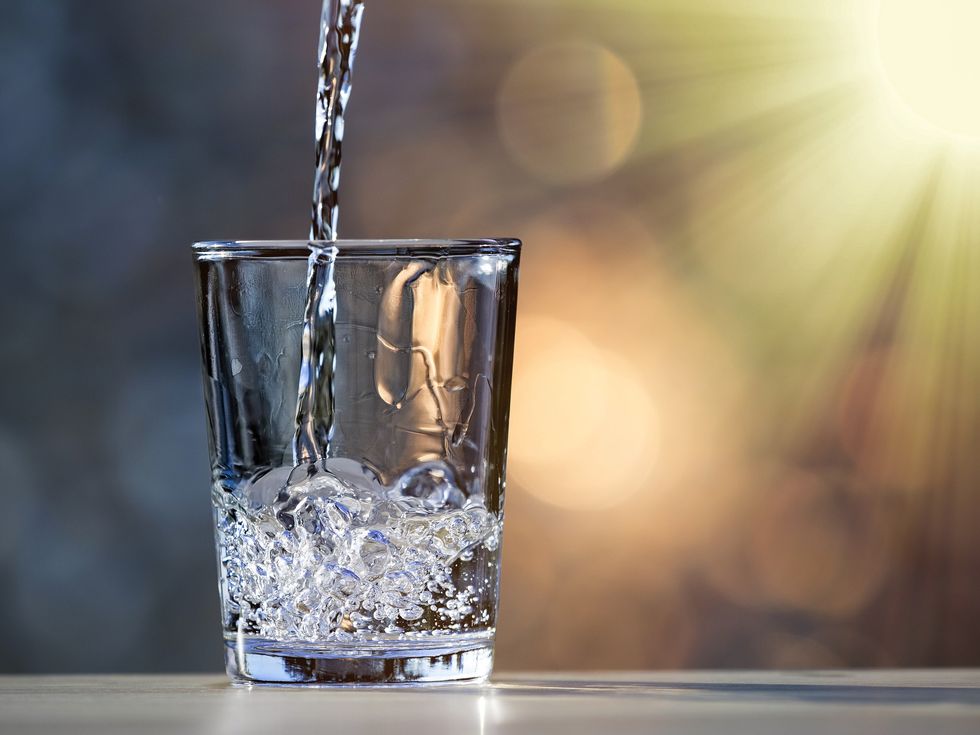
Getty Images
Our bodies are made up of mostly water; so, of course, we need it. How much? For regular maintenance purposes, many health experts say that we, as women, can benefit from nine cups a day. If you want to shed a few pounds, 1-2 liters are recommended. And when it comes to dealing with menopause, in general, and avoiding dry skin that comes from it, at least do the bare minimum (although adding a couple of glasses of water to that would be ideal). The bottom line here is hydrate, hydrate, HYDRATE. If you want to get a leg up on menopausal skin, that’s gonna be how you do it best.
6. Take a Probiotic
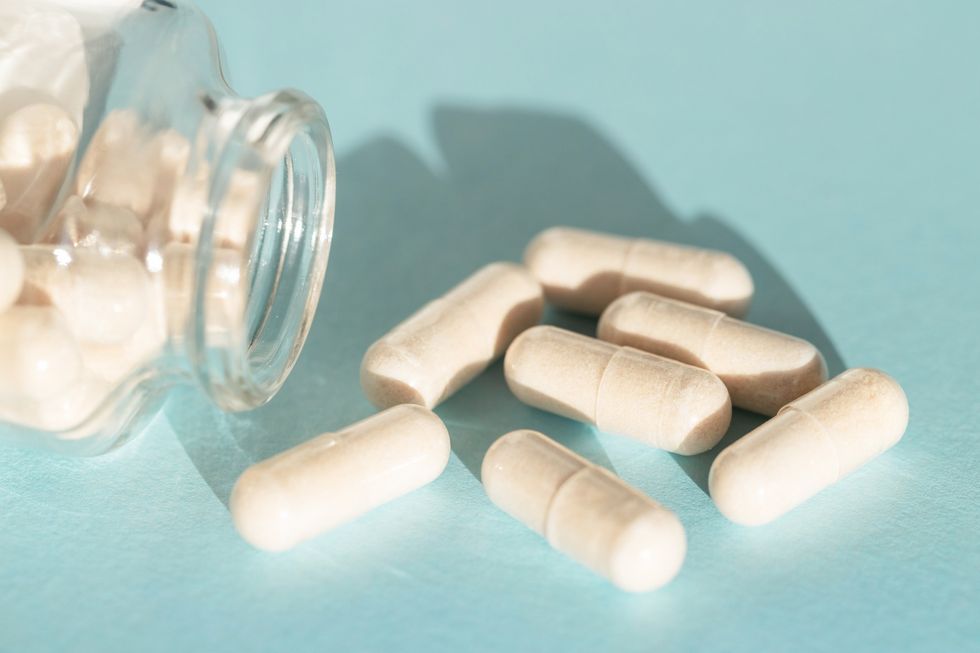
Getty Images
You’re gonna be hard-pressed to read something on gut health and not see a probiotic mentioned (check out “80% Of Your Immunity Is In Your Gut. Take Care Of It Like This.”). That’s because there is plenty of data out here to support that taking a probiotic can do wonders for keeping your intestinal health in great condition. Your skin will thrive off of a probiotic because, not only is it proven to decrease the amount of water that your skin loses, but it also helps to improve the quality of your skin too.
7. “Seal Your Skin” with Marula Oil
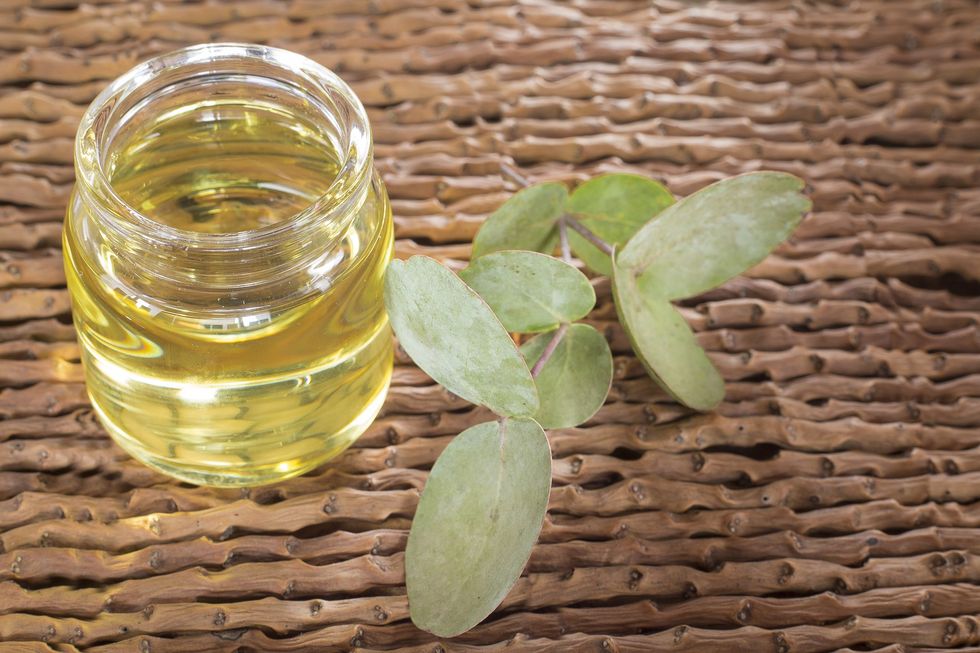
Getty Images
If you want your skin to look as young as it possibly can, it’s always a good idea to look for products that contain a lot of antioxidants, essential fatty acids, and amino acids; one of those is marula oil (which is an oil that comes from marula fruit). In fact, one of the reasons why it gets a shout-out here is a lot of skincare experts recommend that you use it to “seal in moisture.” And since that is a great way to keep water in your skin (for longer) after taking a shower or bath, if you’re looking for the perfect oil to keep your skin feeling super soft and hydrated, hours after washing up, marula oil is one to keep in mind (plum oil is pretty bomb too, by the way).
8. Hyaluronic Acid Is Your Friend
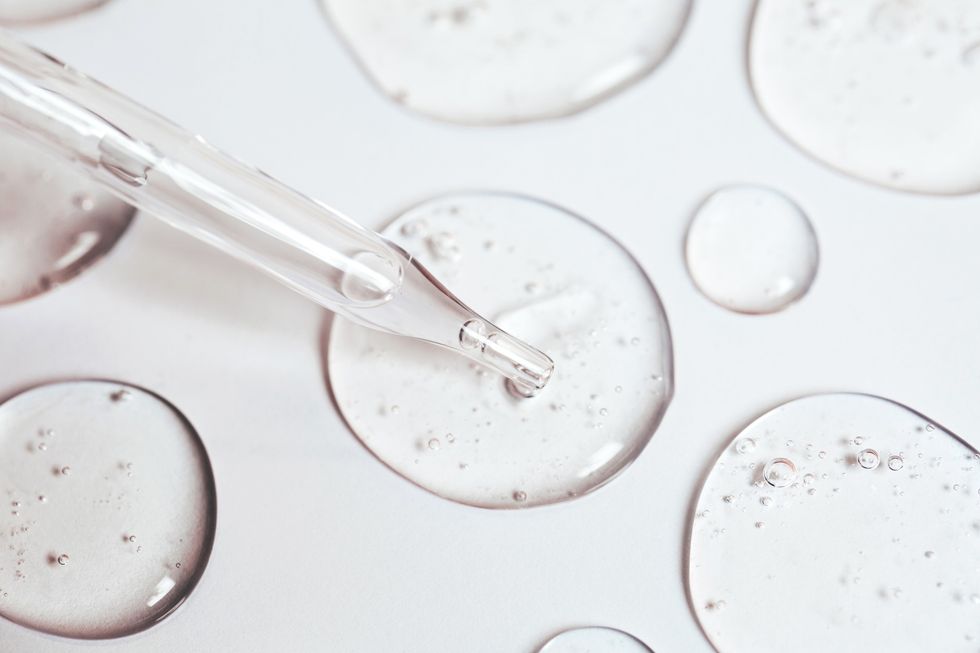
Getty Images
Over the past several months, something that I’ve been becoming more and more of a fan of is hyaluronic acid (check out “Why Your Skin, Hair, And Nails Need Hyaluronic Acid Like...Yesterday”). As far as menopause goes, it can actually help to naturally treat vaginal atrophy in postmenopausal women. Also, when it comes to your skin, since it actually has the ability to make it more flexible — well, that can make fine lines and wrinkles less of a visible issue.
9. Do Chemical Peels
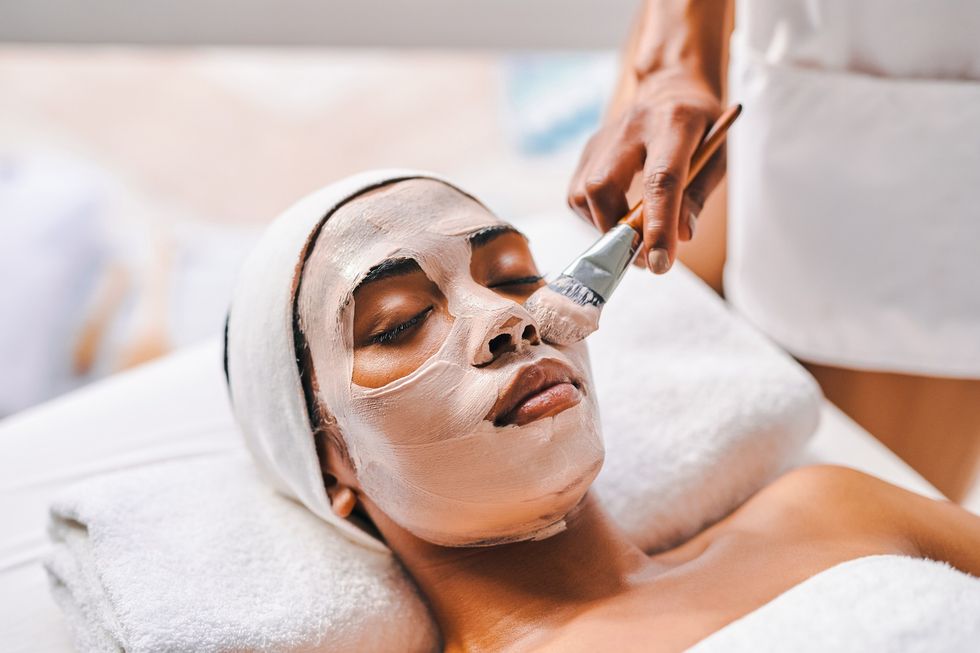
Getty Images
Last fall, I wrote an article for the platform entitled, “I've Been Doing At-Home Chemical Peels. Here Are The Pros And Cons.” I did it because, ever since I started doing chemical peels, I’ve started to see a nice shift in both the appearance as well as the texture of my skin. Anyway, since fine lines and acne are two things that oftentimes come with menopausal skin (more on pimples in a bit), and that is just what chemical peels help to treat, applying them on a consistent basis could be a wise move. You can get a potent chemical peel from a skin professional, or you can do what I do and go the lighter route at home. I’ve had no regrets (other than not fully following the directions and getting a mild chemical burn on my face once in the beginning) since doing so.
10. Try CeraVe (No Joke)
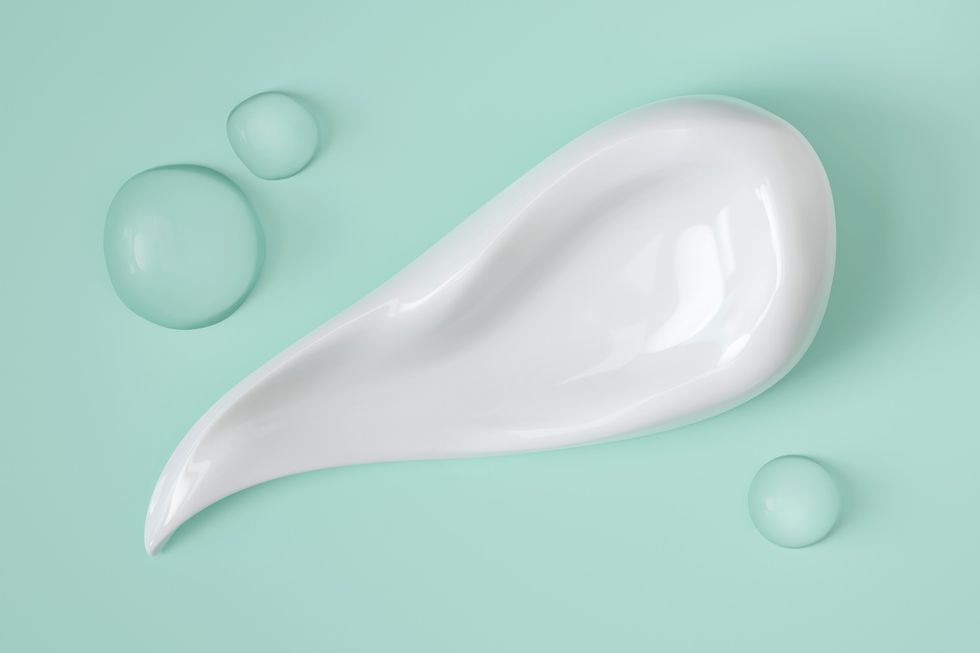
Getty Images
I can’t remember the last time that I watched television, and a doggone CeraVe commercial didn't come on at some point. Personally, I’ve never used any of the products before — I might consider it now, though. Apparently, “the ceramides in CeraVe” are exactly what our skin is longing for during perimenopause and menopause. Long story short, ceramides are the fats that are in our skin cells; they actually make up around 30-40 percent of the outer layers of our skin. And since you not only lose quite a bit of ceramides during menopause, their structure tends to change too — next time you’re at the store, picking up a CeraVe moisturizer certainly couldn’t hurt.
11. Do Research on “Menopausal Acne”
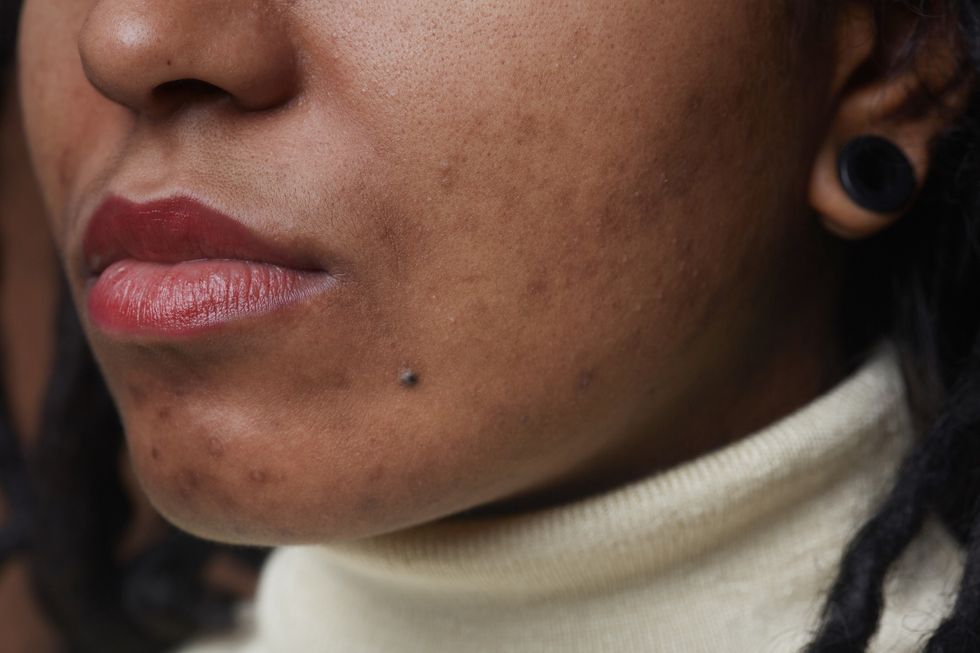
Getty Images
It’s like it never ends. Lawd. Okay, so why in the world, would we as grown-ass women, end up with acne? The bottom line here is just like hormonal fluctuations can trigger breakouts in teenagers, pretty much the same thing can happen to us during perimenopause and menopause. From what I’ve read and researched, as far as how to treat it, you can do similar things that you did as an adolescent (if acne was an issue), including applying benzoyl peroxide and topical retinoids. Although, if you’ve never been to a dermatologist before, this may be the time to do it. They may be able to customize a skincare regimen that can make getting through this season of acne a lot easier for you.
12. Don’t Forget About Sunscreen
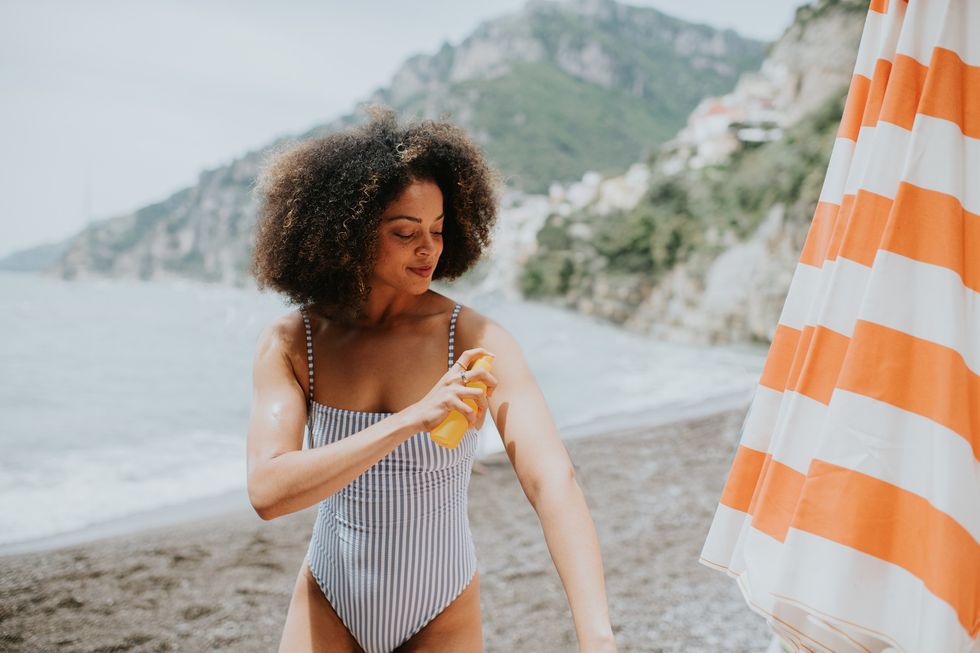
Getty Images
Even though we’re more melanated than any other demographic (and I love that for us!), it is ridiculous to think that skin cancer cares about that. Know what else some of us need to let go of? The belief is that we only need protection from the sun during the summer months. Listen, so long as the sun is shining, rays are beaming, and they can ultimately damage our skin (even in the wintertime). And since menopause makes skin thinner, which ultimately means that it’s more vulnerable, you definitely need to make sunscreen a part of your daily skincare routine, now more than ever. You can check out a list of some of the best sunscreens for our complexion(s) here.
____
Menopause skin prep. Chile, you ain’t gotta tell me — I’m right there with you, somewhere in perimenopause. Hopefully, this intel will make shifting into the transition easier to bear…so that “Black not cracking” can remain intact. Even during the seasons of (perimenopause) and menopause.
Let’s make things inbox official! Sign up for the xoNecole newsletter for daily love, wellness, career, and exclusive content delivered straight to your inbox.
Featured image by FG Trade/Getty Images
- This Is How Actress Kat Graham Achieves Flawless Skin ›
- Perimenopause Has Your Period Being All Over The Place? Here's What To Do. ›
- Why You're Growing Hair On Your Chin & What You Can Do About It ›
- 10 Summer Skincare Trends That Black Women Should Try ›
This Is How To Keep 'Holiday Season Stress' From Infecting Your Relationship
Hmph. Maybe it’s just me, but it seems like there is something really weird happening in the fall season air (because winter doesn’t officially begin until December 21) that cuddle season is in full swing while break-up season is as well. In fact, did you know that break-ups are so popular during the holiday season that December 11 is deemed Break-Up Day?
The reasons why relationships shift around this time vary; however, I did both roll my eyes and chuckle when I read that a very popular one is because it’s an easy way to get out of getting one’s significant other a Christmas present. SMDH.
Anyway, I personally think that the less shallow folks out here may contemplate calling things “quits” or they at least distance themselves a bit from their partner (and what I’m referring to is serious relationships) due to all of the stress and strain that oftentimes comes with the holidays whether it be financial, familial, due to their tight schedules or something else.
Listen, I would hate for you and your man to miss the fun and happiness of experiencing this time of year, all because you are so overwhelmed or irritated that you can’t really enjoy it. That’s why I have a few practical tips for how to avoid allowing the typical holiday season stress from INFECTING your relationship.
Manage Your Expectations
 Giphy
GiphyUnmanaged expectations. If there is a main reason why the holiday season tends to be so stress-filled for so many people, I’d bet good money that this is the cause. And when you’re in a long-term relationship, expectations can manifest themselves in all sorts of cryptic and/or unexpected ways. You might have relatives who assume that you are going to be with them for Thanksgiving or Christmas when you have other plans in mind. You might be thinking that you are going to spend one amount for presents while your man is thinking something totally different. When it comes to scheduling, your signals may be crossed.
And you know what? To all of these scenarios, this is where clear and consistent communication come in. Don’t assume anything. Don’t dictate anything either. From now until New Year’s, mutually decide to check in once a week, just to make sure that you are both on the same page as it relates to the holidays and what you both are thinking will come along with it. The less blindsided you both feel, the less stressed out you will be. Trust me on this.
Set (and Keep) a Budget
 Giphy
GiphyOkay, so I read that last year, 36 percent of Americans incurred some type of holiday-related debt. Hmph. Last year, there was still some sense of normalcy in this country, chile, so I can only imagine what finances are gonna look like over the next several weeks. That said, since I don’t know a lot of people who don’t find being broke stressful, make sure that you and your bae set a budget and then stick to it this year — no ifs, ands or buts.
Because really, y’all — it doesn’t make sense to deplete savings and/or max out credit cards for a few days of giggles only to be damn near losing your mind because you don’t know how to make ends meet come Dr. Martin Luther King, Jr. Day.
And by the way, this tip doesn’t just speak to things like food and gifts; I also mean travel. If it doesn’t make a ton of sense (or cents) to be all over the place this year — DON’T BE.
Keep Matthew 5:37 at the Forefront
 Giphy
GiphyIf off the top of your head, you don’t know what Matthew 5:37 says, no worries, here ya go: “But let your ‘Yes’ be ‘Yes,’ and your ‘No,’ ‘No.’ For whatever is more than these is from the evil one.” That verse right there? Oh, it’s a boundaries lifesaver! I say that because do you see “maybe” or “I’ll think about it” in there? Nope. LOL. It says that you should tell people “yes” or “no” and leave it at that — and that complements Anne Lamott’s quote, “’No’ is a complete sentence” impeccably well. Yeah, you’ve got to remember that anything beyond a yes or no to a request is privileged information; you don’t owe anyone details or an explanation.
Besides, if you are really honest with yourself, when someone asks you something and you give a “Umm, let me think about it” kind of reply, more times than not, you already know what your answer is going to be — so why not let you both off of the hook? Give your response. Commit to that. And let everyone (including yourself) get on with their lives and schedules.
I promise you that when it comes to those holiday parties, you are pissing more folks off by not RSVP’ing or doing so and not showing up than just saying, “Thank you but not this year” off the rip.
Remember That Your Personal Space Is Privilege Not a Right
 Giphy
GiphyA friend of mine recently bought a new house and invited me over to come see it. He’s a single man with no children, so as I was taking in all of the space that he had, especially as I walked through his finished basement, I joked about relatives coming to live with him. “Hell no” and “absolutely not” were pretty much his immediate responses as he went on to say that some folks even had the nerve to be offended when he told them that he had no intentions on taking DNA in.
Ain’t it wild how people think that your stuff is their right? And yes, that brings me to my next point. Your home is your sanctuary space. If you want to host folks this year — cool. If not, ALSO COOL. Please don’t let folks (family included) guilt you into how they want you to act or even into what they would do if the shoe was on the other foot. You are not them — and as one of my favorite quotes states, “If two people were exactly alike, one of them would be unnecessary.” (A man by the name Larry Dixon said that.)
Hell, my friends? They know that I am good for sending them random things that they need or even want all throughout the year. Coming over to hang out at my pace, though. Uh-uh. Chalk it up to being a card-carrying member of the ambivert club yet I like keeping my living space personal — and I sleep like a baby, each and every night, for feeling that way.
Always remember that your space, your time, your resources, your energy and shoot, yourself period (including your relationship), are all things that are your own. You get to choose how, when and why you want to share them. The holiday season is certainly no exception.
Cultivate Some “You Two Only” Traditions
 Giphy
GiphyIt’s not uncommon for some couples to hit me up after the holiday season to “detox.” Sometimes it’s due to the financial drama (and sometimes trauma) that they experienced. Sometimes it’s because they allowed their relatives (especially in-laws) to get more into their personal business than they should’ve. More than anything, though, it tends to be because they didn’t get enough quality time together and so ended up feeling “disconnected.”
Please don’t let that happen. Listen, I’m not even a holidays kind of woman and yet, I will absolutely sit myself down with some hot chocolate and chocolate chip cookies to enjoy a Hallmark holiday film or two. Aside from the fact that most of them are lighthearted and sweet, I also like that they usually focus on couples loving on each other amidst all of the holiday beauty and ambiance — which is something that all couples should set aside some time to do.
Maybe it’s a vacation. Maybe it’s a staycation. Or maybe it’s my personal favorite, A SEXCATION. Whether it’s for a few days, the weekend or even overnight — don’t you let the holidays go by without setting aside time for you and your man to celebrate one another. Don’t you dare (check out “Are You Ready To Have Some Very Merry 'Christmas Sex'?”).
GET. SOME. REST.
 Giphy
GiphyI once read that 8 out of 10 people get stressed out over the holidays and 3 out of 10 lose sleep during to it — and when you’re stress-filled and sleep-deprived, that can absolutely lead to hypersensitivity, making mountains out of molehills and even not being in the mood for sex.
Your relationship can’t afford to go through any of this, so definitely make sure to prioritize rest. I don’t care how unrealistic it might seem during this time, sleep should never be seen as a luxury; it will always and forever be a great necessity.
That said, try to get no less than six hours of shut-eye in (check out “6 Fascinating Ways Sex And Sleep Definitely Go Hand In Hand”) and even ask your bae to take a nap with you sometimes (check out “Wanna Have Some Next-Level Sex? Take A Nap, Sis.”). Not only will sleep help to restore your mind, body and spirit but, when it’s with your partner, it’s an act of intimacy that can make you both feel super connected, even in the midst of what might feel like chaos.
___
Holiday season stress is real. Still, never give it the permission or power to throw your relationship off. Put you and your man first and let the holidays be what they are gonna be, chile.
Let’s make things inbox official! Sign up for the xoNecole newsletter for love, wellness, career, and exclusive content delivered straight to your inbox.
Featured image by Shutterstock
Dreaming Of A White Christmas? These 7 Winter Wonderland Destinations Are Perfect For The Holidays
While most people opt for a tropical vacation during the winter months, there are still many people who want to fulfill their winter wonderland fantasies, which are more than likely centered on watching snow by the fireplace while sipping some hot cocoa.
With Thanksgiving vastly approaching and Christmas a little under a month away, there is still time to ditch the traditional Christmas home to visit family or friends.
Whether you’re looking to put a new stamp on your passport and keep things domestic with a destination in the States, xoNecole has you covered with a few hotspots for those itching to go somewhere cold (but with cozy vibes) this holiday season.
Aspen, Colorado
Our Christmas queen, Mariah Carey, has been taking an annual trip to this snowy destination since 1997, just three years after dropping the track that would make her the unofficial (but official to us) ambassador of the winter holiday.
Aside from being a key vacation spot for one of the culture’s greatest musicians, Aspen also offers travelers access to world-class skiing and snowboarding and four distinct mountains that provide the perfect backdrop for a winter vacation.
Whistler, British Columbia, Canada
Home to the largest ski resort in North America, Whistler Blackcomb, this destination is located in the Coast Mountain Range and is about 75 miles north of Vancouver.
From luxury spas like Scandinave Spa Whistler to Olympic Park, this is another top winter vacation spot that offers a unique experience for people who love snow and the thrill of a good adventure.
Western Massachusetts
Dubbed the place for a magical holiday escape, Springfield, Massachusetts, blends the warmth of small-town charm with unforgettable experiences like Grinchmas at Springfield Museums, Winterlights at Naumkeag in Stockbridge, Historic Deerfield’s Winter Frolic, and many others.
This destination offers something for all ages, and it’s close to home, making it all the more reason to place on your radar for a winter getaway.
Rovaniemi, Finland
If you want to really get into the Christmas spirit, this just may be the place for you. As the official home to Saint Nick himself, Rovaniemi, Finland offers reindeer sleigh rides, the opportunity to stay in a glass igloo, as well as an opportunity to experience the Santa Claus Village.
Lake Tahoe, California/Nevada
Who says that visits to the lake house are only reserved for summer vacation? A winter trip to Lake Tahoe is equipped with stunning lake views and top-notch ski resorts, including Heavenly and Northstar.
Chamonix, France
Sitting at the base of Mont Blanc, Chamonix, France, is known for its skiing and mountaineering. This destination is home to the Aiguille du Midi cable car, the charming Alpine village, and is also close to various other European ski destinations.
Northeastern Pennsylvania
This area of the U.S. state is home to the Poconos Mountains, whose renowned ski resorts include Camelback Mountain, Blue Mountain, and Jack Frost Big Boulder. Whether you’re a ski expert, a beginner, or just there for the vibes, this destination makes for a winter vacation that balances fun adventures and cozy getaways. Additionally, Pennsylvania is home to the Christmas Tree Capital of the world.
Feature image by Shutterstock
Originally published on November 23, 2024

